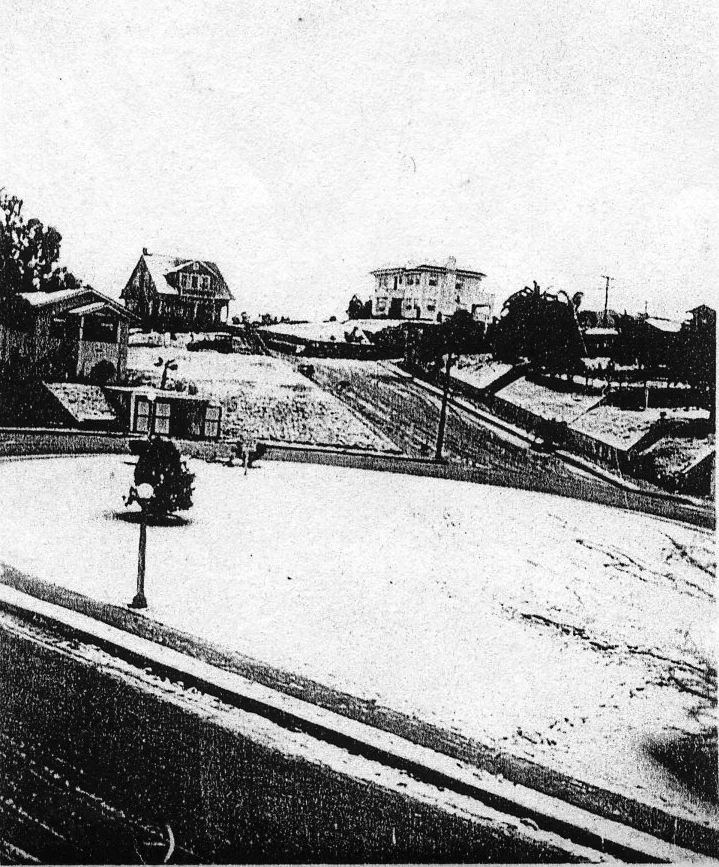Uniting the residents and friends of Everett Park.
The neighbors and friends of Everett Park have come together to celebrate and preserve the history of this remarkable street and park. As the City of Los Angeles faces another critical moment in its urban development, we believe it is crucial to protect the historic homes and neighborhoods that are integral to the fabric and story of this wonderful city.
A slice of Early Los Angeles history...
In the early 1900s, residents and visitors would depart the newly established, electric powered Trolley Line on Sunset Blvd. and walk up the street to the small grassy, hillside park shaped like an upside-down teardrop. There, they enjoyed unparalleled views of the Los Angeles basin and the charm of turn-of-the-century homes lining the street – homes that were to witness massive changes across the basin in decades to come. Today, the teardrop park, with its four majestic pine trees, is known as Everett Park and the steep, surrounding street is called Everett Street. It still offers a distinctive, natural space for local residents and visitors to gather and gaze out over the city. Sometimes, on a clean crisp day, Catalina Island can be seen far on the horizon from the top of the park. Over the years, countless film and television productions have taken advantage of this picturesque setting and exceptional views. Although it is enveloped today by the larger neighborhood of Echo Park, Everett Street remains a unique, cul-de-sac community with a wealth of history representing the city’s broad cultural and ethnic diversity.
Situated on the eastern edge of the original 1886 Angeleno Heights Tract, Block 31, or the present day Everett Street, was part of the first suburban development of Los Angeles. The development is second only to Bunker Hill as the oldest district in LA. Originally subdivided by William Stilson and his partner Everett E. Hall, Angeleno Heights was marketed to the local elite during the construction boom of the 1880s. Unfortunately by 1888–during the Tract's formative years–the U.S. economy and housing market collapsed and development abruptly halted. Stilson would not see the U.S. economy pick up again in his lifetime. He
died later that year leaving his widow Mary Stilson to take charge of the struggling tract development. Enlisting her son, Fielding, they began commissioning spec houses designed by the firm of Aiken and Benton to promote and sell the rest of the Angeleno Heights lots. Fielding Stilson's new vision for the development differed from his father's Victorian preferences. He favored the growing Arts and Crafts movement, and the architecture of the homes erected between 1900-1915 reflects this shift in aesthetic.
Shortly after 1900, Mary and Fielding sold lots 30, 32, 34 and 38 of Block 31 to Mr. Timothy S. Abbott, an Architect/Builder/Owner, who built several houses on Everett Street (1003, 1005 & 1013). The Abbott Everett House (1003) in particular stood for over a century as a great example of early American Four Square architecture with hints of Craftsman influence, until its demise in 2016 at the hands of developers. When Timothy’s brother, Edward H. Abbott, purchased lot 36, he constructed three more buildings, including a 12-room, two-story building for the purpose of "Flats.” In 1903, Timothy sold lot 30 to John Restovich, who built a Neoclassical style home now known as The Restovich House. The Restovich House was landmarked in 2016 as a Los Angeles historic cultural monument and is considered a “rare, intact example of early residential development in the area.”
Timothy and Edward Abbott knew a great thing when they saw it, establishing a large presence in the development of Everett Street’s distinctive circular drive. They erected their properties directly across the street from the park, taking full advantage of the unique setting and sweeping views. Others followed their lead, as evidenced by the presence of Craftsman, Prairie Boxes, and Bungalow homes that remain. Today, these surviving early homes mingle with the 1960s and 70s apartment complexes lining the street and the park, both named after Stilson's partner Everett E. Hall.
Hall’s influence on the development of Angeleno Heights extends down the hill and across Sunset Blvd. to Marion Ave., which was named after his daughter. He also constructed his home at 917 Douglas and “The Hall Twins” – two identical Victorians built for two members of the Hall family at 1343 and 1347 Kellam Ave.
Unfortunately, the buildings surrounding Everett Park, and the Park itself, were not included in the Angeleno Heights Historic Preservation Overlay Zone (HPOZ) of 1983 – the first designation of its kind in LA. Consequently the early residences on Everett Street do not enjoy the protection their Angeleno Heights sisters receive, which leaves them exposed to careless developers. With the recent demolition of the Abbott Everett House, the last of the six historic Abbott brothers' developments has been lost. To date, nearly a third of the original buildings on Everett Street have been demolished or altered beyond recognition, and it has become abundantly clear that the legacy of this quaint and historic hilltop community is greatly threatened by a lack of awareness and respect by self-interested parties.
The neighbors and friends of Everett Park have come together to share the community's story and our appreciation for it with the greater public. Please join us in working to preserve a truly unique part of the city; its homes, its park, its history is where Los Angeles began.
Learn more and get involved
Everett Park in Film and Television
Films
Training Day (2001)
Drag Me to Hell (2006)
The Italian Job (2007)
Hancock (2008)
The Nice Guys (2014)
The Listener (2021)
Television Productions
Hunter (1980s)
Murder She Wrote (1980s)
Monk (2003)
The Division (2004)
10-8 (2005)
CSI LA (2009)
Southland (2011)
Latin Grammies (2015)
Murder in the First (2016)
Training Day TV (2016)
Hand of God (2016)
A Lot (2016)
And many more!
Join the mailing list for updates or email us at everettstreetneighbors at gmail.










